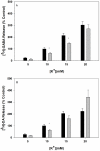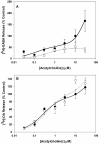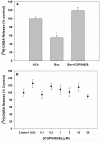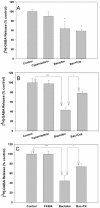Presynaptic GABAB autoreceptor regulation of nicotinic acetylcholine receptor mediated [(3)H]-GABA release from mouse synaptosomes
- PMID: 24953818
- PMCID: PMC4140098
- DOI: 10.1016/j.bcp.2014.06.010
Presynaptic GABAB autoreceptor regulation of nicotinic acetylcholine receptor mediated [(3)H]-GABA release from mouse synaptosomes
Abstract
Activation of nicotinic acetylcholine receptors (nAChRs) can elicit neurotransmitter release from presynaptic nerve terminals. Mechanisms contributing to cell-and-terminal specific regulation of nAChR-mediated neurotransmitter exocytosis are not fully understood. The experiments discussed here examine how activation of GABAB auto- and hetero-receptors suppress nAChR-mediated release of [(3)H]-GABA and [(3)H]-dopamine ((3)H-DA) from mouse striatal synaptosomes. Activation of presynaptic GABAB receptors with (R)-baclofen decreased both [(3)H]-GABA and [(3)H]-DA release evoked by potassium depolarization. However, when nAChRs were activated with ACh to evoke neurotransmitter release, (R)-baclofen had no effect on [(3)H]-DA release, but potently inhibited ACh-evoked [(3)H]-GABA release. Inhibition of nAChR-evoked [(3)H]-GABA release by (R)-baclofen was time sensitive and the effect was lost after prolonged exposure to the GABAB agonist. The early inhibitory effect of GABAB activation on ACh-evoked [(3)H]-GABA release was partially attenuated by antagonists of the phosphatase, calcineurin. Furthermore, antagonists of protein kinase C (PKC) prevented the time-dependent loss of the inhibitory (R)-baclofen effect on [(3)H]-GABA release. These results suggest that α4β2*-nAChRs present on GABAergic nerve terminals in the striatum are subject to functional regulation by GABAB autoreceptors that is apparently cell-type specific, since it is absent from DAergic striatal nerve terminals. In addition, the functional modulation of α4β2*-type nAChRs on striatal GABAergic nerve terminals by GABAB autoreceptor activation is time-sensitive and appears to involve opposing actions of calcineurin and PKC.
Keywords: Calcineurin; GABA(B) receptor; Neurotransmitter release; Nicotinic receptor; Protein kinase C.
Copyright © 2014 Elsevier Inc. All rights reserved.
Figures









References
-
- Gotti C, Clementi F, Fornari A, Gaimarri A, Guiducci S, Manfredi I, Moretti M, Pedrazzi P, Pucci L, Zoli M. Structural and functional diversity of native brain neuronal nicotinic receptors. Biochem Pharmacol. 2009 Oct 1;78(7):703–11. - PubMed
-
- Lukas RJ, Changeux JP, Le Novère N, Albuquerque EX, Balfour DJ, Berg DK, Bertrand D, Chiappinelli VA, Clarke PB, Collins AC, Dani JA, Grady SR, Kellar KJ, Lindstrom JM, Marks MJ, Quik M, Taylor PW, Wonnacott S. International Union of Pharmacology. XX. Current status of the nomenclature for nicotinic acetylcholine receptors and their subunits. Pharmacol Rev. 1999;51(2):397–401. - PubMed
-
- Flores CM, Rogers SW, Pabreza LA, Wolfe BB, Kellar KJ. A subtype of nicotinic cholinergic receptor in rat brain is composed of alpha 4 and beta 2 subunits and is up-regulated by chronic nicotine treatment. Mol Pharmacol. 1992;41(1):31–7. - PubMed
-
- Orr-Urtreger A, Göldner FM, Saeki M, Lorenzo I, Goldberg L, De Biasi M, Dani JA, Patrick JW, Beaudet AL. Mice deficient in the alpha7 neuronal nicotinic acetylcholine receptor lack alpha-bungarotoxin binding sites and hippocampal fast nicotinic currents. J Neurosci. 1997 Dec 1;17(23):9165–71. - PMC - PubMed
Publication types
MeSH terms
Substances
Grants and funding
LinkOut - more resources
Full Text Sources
Other Literature Sources
Molecular Biology Databases

